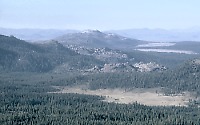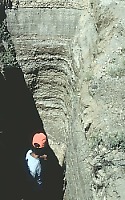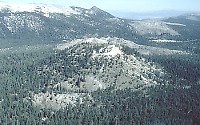Volcano Hazards in the Long Valley - Mono Lake Area, California
Volcanic unrest through the 1980's and 1990's in the southern part of the Long Valley caldera reminds us that this is a young volcanic system. Volcanic activity and associated hazards are likely sometime in the future. Long Valley Observatory scientists closely monitor the area and research past activity to better understand what might happen in the future.
Although pinpointing the precise time and location of the next eruption in the Long valley area is not feasible, scientists can identify areas that are likely to be affected from different types of future volcanic activity. Knowing the potentially dangerous areas before an eruption starts is critical for planning emergency procedures that can help ensure public safety if the unrest leads to volcanic activity.
The Past is the Key to the Future
Future eruptions in the region are most likely to consist of one or more of the types of volcanic activity that have occurred in the past few thousand years along the Mono-Inyo Craters volcanic chain, which cuts through the western part of the caldera. This activity included (1) explosive eruptions that produced fast-moving pyroclastic flows that spread several kilometers from the vents and widespread ashfall; and (2) nonexplosive eruptions of thick lava flows and lava domes. Some of these eruptions were probably accompanied by mudflows, caused by rapid snowmelt during explosive activity.
Scientists use volcanic rock deposits and layers formed by past eruptions as a guide to identify areas in the region that are likely to be affected by similar types and sizes of eruptions in the future.
Knowledge of the distribution of these deposits and familiarity with similar historical eruptions from around the world permit scientists to identify potentially hazardous areas on a map for different vent locations and different types of eruptions. Since the Long Valley region consists of many possible vent locations that can produce different types of eruptions, the actual hazardous areas may not be known until hours before or just after an eruption begins.
Even so, maps showing volcano-hazard zones and examination of several possible eruption scenarios can help to identify (1) possible vent locations; (2) potential hazardous areas; and (3) different types of eruptions that can occur.
How likely is volcanic activity in the Long Valley area?
Based on the frequency of eruptions along the Mono-Inyo Crates volcanic chain in the past 5,000 years, the probability of an eruption occurring in any given year is somewhat less than one percent per year or roughly one chance in a few hundred in any given year. This is comparable to the annual chance of a magnitude 8 earthquake (like the Great 1906 San Francisco Earthquake) along the San Andreas Fault in coastal California or of an eruption from one of the more active Cascade Range volcanoes in the Pacific Northwest, such as Mount Rainier in Washington or Mount Shasta in California.
Increased volcanic unrest (including earthquake swarms, ground deformation, and CO2 gas emissions) in the Long Valley area since 1980 increases the chance of an eruption occurring in the near future, but scientists still lack adequate data to reliably calculate by how much. Volcanic unrest in some other large volcanic systems has persisted for decades or even centuries without leading to an eruption. But since volcanic unrest can escalate to an eruption quickly--in a few weeks, days, or less--USGS scientists are monitoring the activity closely.
The Inyo Eruption 550-650 years ago: sequence of events and effects in the Long Valley area
Geologists have pieced together the dramatic sequence of eruptions and ground cracking that occurred along the Inyo volcanic chain about 600 years ago. This eruptive sequence provides probably the best "scenario" for future volcanic activity in the Long Valley area.References
Miller, C.D., Mullineaux, D.R., Crandell, D.R., and Bailey, R.A., 1982, Potential hazards from future volcanic eruptions in the Long Valley-Mono Lake area, East-Central California and Southwest Nevada -- a preliminary assessment: U.S. Geological Survey Circular 877, 10 p.
Miller, C.D., 1985, Holocene eruptions at the Inyo volcanic chain, California: Implications for possible eruptions in Long Valley caldera: Geology, v. 13, pp. 14-17.
Miller, C.D., 1989, Potential hazards from future volcanic eruptions in California: U.S. Geological Survey Bulletin 1847, 17 p.





